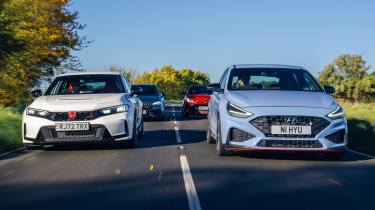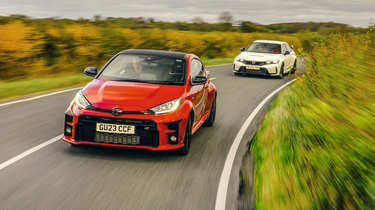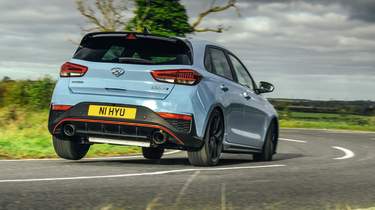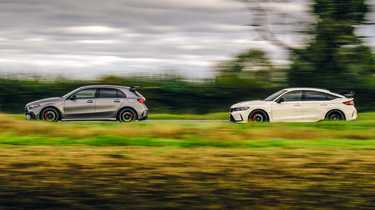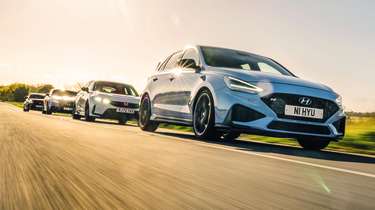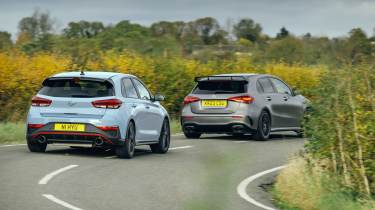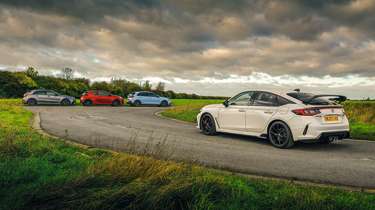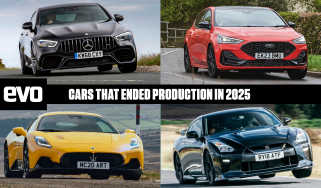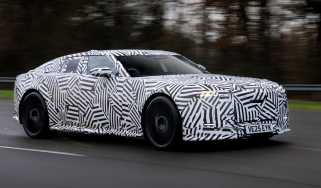Toyota GR Yaris v Mercedes‑AMG A45 S v Hyundai i30 N v Honda Civic Type R
The rally-bred Toyota GR Yaris, bombastic Mercedes‑AMG A45 S, thrillsome Hyundai i30 N and dazzling Honda Civic Type R are each brilliant in their own way, but which delivers the purest hit of driving pleasure?
In a shoot-out to find the greatest hot hatch you can still buy, it’s a shame that the car that has defined the genre for nearly five decades doesn’t make the cut. Volkswagen might not have been the first company to make a hatchback hot, but when it launched the first Golf GTI back in 1975 it turned a niche into a segment; it was originally planned as limited-edition run of 5000, but by 1983 over 450,000 Mk1 GTIs had been sold.
As we know from film franchises, rock bands and book series, not every follow-up hits the heights of the original, and certain generations of Golf GTI have under-delivered. Sadly, the long-established strengths and charms of the hot Golf are particularly hard to find in the current Mk8 GTI and R, but there is a car in our four-car final that shows what the current Golf might have become had Volkswagen’s engineers maintained the model’s focus and upward trajectory. That car is the Hyundai i30 N.
> The best hot hatchbacks on sale
There was nothing groundbreaking about the front-drive, four-cylinder, transverse-engined i30 N at launch in 2017. Hyundai didn’t chase Nürburgring times or headline power figures, it simply fashioned a hot hatch that nailed the brief: well-made, comfortable and practical in everyday use, fast and fun one-up. Very Golf, though this shouldn’t be a surprise given that it was developed under Albert Biermann, the ex-BMW M engineer who went to Hyundai to head up R&D.
We’ve rated the i30 N highly from the start, and the mid-life refresh in 2020 has helped maintain its appeal. If you analysed its key attributes – handling, steering, refinement, performance, etc – and plotted them on a spider chart, the resulting web would stretch evenly in all directions; the i30N is the perfectly centred, archetypal hot hatch.
It’s got its work cut out here, though, up against the Honda Civic Type R, another front-drive hatch but one that’s been every bit as obsessively honed, the Toyota GR Yaris, a four-wheel-drive, three-cylinder hatch that’s actually a rally car in road trim, and the Mercedes-AMG A45 S, also four-wheel drive and the most potent production hatch ever. They each push and pull that spider chart in different directions, but which is the most compelling, which has the most desirable blend of attributes? In short, which is the greatest hot hatch?
Yesterday, slip-sliding around on the cold, wet asphalt of the Bedford Autodrome, the car most out of sorts was the Hyundai; its Pirellis just didn’t cut through. The ostensibly similar Honda was a remarkable contrast, bombing around on its Michelins almost as if the track was dry. Being able to find grip on a slick surface is an uncanny knack Honda shares with Porsche. The Civic’s handling is pretty strait-laced though, in sharp contrast to the Mercedes, which has the best kind of four-wheel drive. It gets plenty of grip from its Michelins and it’s equally happy being neat or loose, efficient or fun; keep your foot in and the balance of power will shift to the rear, meaning it’s hugely entertaining on a slippery track and has an agile feel on the road, too. The Toyota was also playful, finding big drift angles, though it would have been more effective had it been the Circuit Pack version with front and rear Torsen diffs to help draw the car out of corners.
I took the GR Yaris home and the on-track feel lingered on wet B‑roads; steer into a quick turn and the feedback through the wheel suggested a small delay and mild slip. Having been brought up on Impreza and Evo rally reps, treading gingerly on a gnarly, drizzly B‑road felt… odd. Then, out of a small roundabout close to home, it hooked up and rocketed out, full boost in harness, like a cork from a bottle.
Today is quite the contrast weather-wise, with clear skies and roads that are damp in patches but drying and warming. As modern cars go, the GR Yaris is a strong flavour, with distinct ergonomics, tactility and dynamics. There’s nothing quite like it. Hop in and it seats you high… or is it just how the standard Yaris driving position and the GR’s lowered roofline combine? Then there’s an impression of mass, created by the weight of the steering, the heft of the manual gearshift and the languid sound of the 1.6-litre triple.
We know it’s not actually that heavy – this car weighed in at a whisker under 1300kg – but it has a sense of inertia that is not totally countered by the full-boost thrust of the three-cylinder motor. This is partly because, although there’s a solid shove from low revs that’s sustained through to 6000rpm, the engine still sounds relaxed and the gearshift has a weight and precision that feels more appropriate to a car with humungous torque, an Aston V12 Vantage, say.
Dynamically, it’s more positive on these dry roads. Again, we’d have preferred a Circuit Pack car with stiffer suspension and those diffs, but while it does get jostled a bit by bumps, the character and malleability are still here in spades. Through a tight series of S-bends it’s sensational, tucking into apexes and sling-shotting out on a wave of boost, traction absolute. Antony Ingram likens the feeling to ‘a rope around a lamp post’.
Straight after, the Hyundai feels low-slung but a little plain (so do the Honda and Mercedes, to be fair) but within a mile you’re starting to acclimatise and appreciate the qualities of the i30 N. Like the Yaris, it has firm, well-shaped and comfortable seats, the steering wheel is the ideal size and shape, and the driving position is spot on, so you quickly feel at home. There are three distinct drive modes, but even in the most comfortable the exhaust note has a fruity timbre and there’s a well-judged tautness to the ride and handling, a lightly filtered directness, an edge with a nice bevel to it. It’s comfortable but you feel connected.
On damp patches shaded by trees you can feel the grip drop off, but there’s an underlying poise and precision. There’s enough performance, the manual gearshift is sweet and snappy, and it’s fun to hustle because it’s such a transparent car. There are plenty of tailoring options too: you can make it louder, make it stiffer, make the delivery more urgent, but whatever set-up you choose, the i30 N harmonises the elements for a rewarding, exciting drive. You can’t say much fairer than that.
Dep ed Taylor has just tried the Yaris. ‘I think all the hype this car has received is justified, although I think maybe it doesn’t come alive unless you’re really going for it. It seems churlish to criticise a car for being too good. A Circuit Pack car would have been better – the damping on that model is brilliant – but what an engine!’
Ingram has been driving the car I’m keen to try next, the Mercedes. ‘I like how energised it feels from the moment you start it, with a fizz to the engine even at idle that seems to permeate the cabin,’ he says. ‘The engine is still magnificent; it pulls from almost nothing all the way to the red line. The chassis is great too, almost feels rear-driven a lot of the time… but I’m convinced the steering isn’t as good as it used to be: it’s strangely dead for an eighth of a turn either side of straight-ahead. And I found the seats outright uncomfortable in a way I don’t remember previously.’
Even three years after its launch, 415bhp still sounds like a ludicrous amount of power in a hot hatch and an incredible output from a series-production, 2-litre, four-cylinder engine. As well as packing a lot of power, the A45 S also packs a lot of glitz on the inside, the cabin decked out with seemingly every conceivable interior trim and finish, including leather and a suede-like cloth with yellow stitching and inserts, piano black panels, and satin and chrome metal finishes. There’s a lot going on, and the centrepiece is a weirdly wide screen that looks like a three-foot-long iPad.
Considering its potential, initially it’s surprisingly laid-back, breezing along on a remarkably supple suspension, the auto ’box slurring between gears, but it can pick up the pace in the blink of an eye or, more accurately, a stab of the throttle, a torrent of power suddenly shoving you down the road. If you want a soundtrack to match, you can use the mode button hanging off the steering wheel to select Sport or Sport Plus and ramp things up. You get a bombastic engine note, the shifts become sharper and the damping gets a firmer hold of the weight too, and yet even in the firmest setting it’s still absorbent, taking the sting out of everything a B-road can throw at it. That suppleness is perhaps why the four-wheel drive never struggles to get every last ounce of torque to the road, even out of tight corners.
It’s dynamic, too, rotating into turns so that when you get back on the throttle the load is on the rear, ready to drive out. From previous experience we know that if you keep the boost up through a long enough corner, you’ll exit with a comfortable few degrees of opposite lock. However, as Ingram says, the steering of this car leaves something to be desired; it’s dead around the straight-ahead, so you’re not quite sure where you are with the A45 S when you make small inputs, which wouldn’t have been apparent yesterday sliding around the track. I agree with him about the seats too; they’re the firmest here with a pronounced lumbar shape that I find a bit uncomfortable.
Taylor has found the i30 N to his liking. He ran an early car as a long-termer so this is a welcome refresher: ‘Only good memories of it,’ he says. ‘It’s a great car.’ Is there’s anything he’d change? ‘I think the steering is too heavy, almost too much in its heaviest settings; a bit macho for me. The exhaust sound is OTT too, though it feels part of the car’s character rather than something that’s a bit synthetic.’
Initially, the Honda feels much like the Hyundai in terms of the detail and character of feedback, its ride slightly firmer at first, though with a bit of speed under its wheels it smooths out nicely. And just a few hundred yards after setting off, exactly what was missing from the A45’s steering is demonstrated emphatically as the road starts to wind its way up a gradient, twisting and turning but well-sighted. In your mind’s eye you pick the lines, your hands make the inputs and you find the Civic is on the exact line you wanted, and the next, and the next. With single steering inputs you carve neatly through the turns, while adding to the sense of precision and calm is the chassis, rotating the car just so and filtering out all the noise from the bumps. There’s a rare and wonderful quality to its dynamics, a clean, effortless precision that genuinely does bring to mind the 911 GT3.
The Civic is a much simpler car than the Yaris but it’s every bit as much a product of obsession, and in a much more subtle, long-game way. The Type R team were able to influence the design of the regular Civic at its inception, building in specific strengths and engineering details they would need to deliver the Type R’s extraordinary dynamic fidelity. And deliver they most certainly have.
There was magic like this in the last Civic Type R but it feels like it has been honed and refined to an even more exceptional level, and there’s plenty more to enjoy too. Usually, if the feel of the brake pedal doesn’t draw attention to itself, it’s fine, but the Honda’s pedal stands out because it is so brilliantly judged: perfect response stepping in light or hard, terrific progression and easy modulation. And you won’t find a better gearshift anywhere, the Civic’s little silver lever snicking around the gate with a satisfying precision and ease.
The A45 has the advantage in performance here, but it’s an edge rather than a gap. There’s a gruffness to the Civic’s engine note and its delivery feels not that far behind the Mercedes’ stellar unit, partly because the two cars’ power-to-weight ratios are closer than you might think. The Type R looks a size bigger than the competition, yet at 1439kg on our scales it’s actually 19kg lighter than the i30 N. And while the A45 looks compact, it weighs 1662kg, making it over 200kg heavier, which is like being four-up while the Civic is driver‑only.
The Honda whips through turns in a much cleaner manner than any of the others here, front grip seemingly undefeatable, the rear absolutely nailed down. Hot hatches don’t normally handle like this. You can feel the weight transfer as you tip the Hyundai into a corner, sometimes sense a slight lift of an inside-rear wheel, while the Mercedes is set up to get the rear involved and then send drive there. And the Yaris? It feels tall and small and enjoys tucking into tight turns more than peeling into fast sweepers, which, as Ingram says, seems as much down to its short wheelbase as its chassis set-up.
‘The Civic’s handling is very much go-where-you-point-it,’ says Taylor, ‘so it’s a less expressive character than the i30 N and the A45, but there’s a lot of satisfaction to driving it slowly as well as quickly.’ Ingram is impressed by the Honda’s dynamics too: ‘I’m surprised and glad the ride doesn’t seem notably worse than the FK8’s, despite what I’d heard elsewhere – our test route is hardly glassy-smooth, but the Civic never feels harsh and has all the control you could ask for.’
A brief huddle is all it takes to come up with our finishing order. Fourth is the Mercedes. We love that the A45 S has so much performance but what makes it a blast is that the four-wheel-drive system and supple chassis have been configured to exploit and deploy it, to enjoy it in a way that many front-drive cars made all-wheel drive (Golf R, M135i…) simply don’t. This post-facelift example is not quite the car we remember, its steering disappointingly remote on-centre, but hopefully this is just a quirk of this particular car.
The Hyundai finishes a strong third. It’s such an easy car to get into the groove with, so communicative and so transparent in its dynamics, with accurate, tactile steering, good control weights and a slick gearshift. The drive modes offer distinct characters for different scenarios and, as Ingram observes, there are enough tuning options via the ‘Custom’ menu for any driver to tailor an ideal set-up. It’s the most typical of hot hatches here and demonstrates how good the formula still is, being great to drive, practical, solidly built, decently refined and excellent value. It would slot into your life as easily as, well, a Golf.
The GR Yaris just gets the nod for second place. We love that this car exists at all, that Toyota built a bespoke, three-door Yaris for rallying and made a road car version too, and for an attractive price. And also that it’s following it up with a Gen 2 version (see page 12). You can tell it’s a rally car from the shift of its bombproof six-speed gearbox, the unburstable feel of its gutsy three-cylinder motor, the solid integrity of its body and the level of road noise from its ball-jointed suspension. Ergonomically it’s not perfect and dynamically we’d prefer the Circuit Pack chassis for the extra directness, grip and control, and the diffs. Well, most of us would: Ingram, who has it on his list of cars he’d like to own, says: ‘I don’t honestly miss the Circuit Pack on the road.’
Which means our winner, by a unanimous decision, is the Honda Civic Type R. The composure and effortless precision of the Civic are sensational, and much else is five-star quality too, from the brakes to the gearshift to the seats. Its depth of ability makes it a remarkable car by any measure.
‘You sense that every single individual involved in its development was on exactly the same page, from the people who make one of the world’s best gearshifts to whoever engineered the click of the heating controls,’ says Ingram. ‘If Honda could somehow engineer-in some of the old naturally aspirated character and sound, it’d be damn near perfect.’
‘It feels like a bigger car now,’ says Taylor, ‘but I love the clarity of it, the feedback through all the controls, the precision of everything. It’s become a cliché, but it really is the hot hatch equivalent of a GT3. Objectively, it’s probably the best front-wheel-drive car I’ve driven.’
The Civic Type R is simply sublime, the most polished, poised and accomplished hot hatchback of all time, and it ensures that the time-served and much-loved internal-combustion hot hatch genre goes out on the highest of highs.
This story was first featured in evo issue 318.

